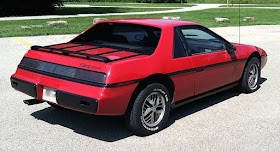Regular readers know that I am not a fan of rear-mounted motors or of so-called mid-engine placement. This is despite the fact that my father owned a Porsche 912 and then a 911, and that I owned a mid-engine Porsche 914. Mid-mounted motors seem fine for racing cars, but are not very compatible with good use of non-engine space. Their weight distribution tends to be rear-biased, and this can create control problems such as I once experienced on a snowy road in upstate New York. Finally, and most important when it comes to the focus of this blog, it is difficult to style a car whose motor sits over, or slightly forward of, the rear axle line.
Regarding that last point, I think Pontiac stylists did a pretty good job. The Fiero was designed a few years before aerodynamic efficiency became a key determinant of a vehicle's general shape. At that time, the fashion was for a crisp, taut appearance based on simple, slightly curved surfaces joined in beveled-like fashion. So far as mid-engine cars are concerned, Giugiaro's 1970 Porsche 914/916-based Tapiro concept car that I discussed here might have inspired some of the stylists on the project.
Mecum auction photo front 3/4 view of a 1984 Pontiac Fiero. Headlights are in flip-up panels just aft of the bumper zone. When raised, they reduce whatever aerodynamic efficiency the Fiero design possesses. The rub-rail that extends around the car helps tie the design elements together.
A brochure spread showing internal features of the 1984 Pontiac Fiero (click to enlarge). The engine placement, besides reducing potential luggage storage space, makes it very difficult to include a large, curved backlight window. This is due to the need to have access to the motor.
This 1984 Fiero 500 has a slightly different nose than regular Fieros, as can be seen in this Mecum auction photo (the rub rail on the side does not continue around the front end).
Rear 3/4 view Mecum auction photo of a '54 Fiero.




No comments:
Post a Comment